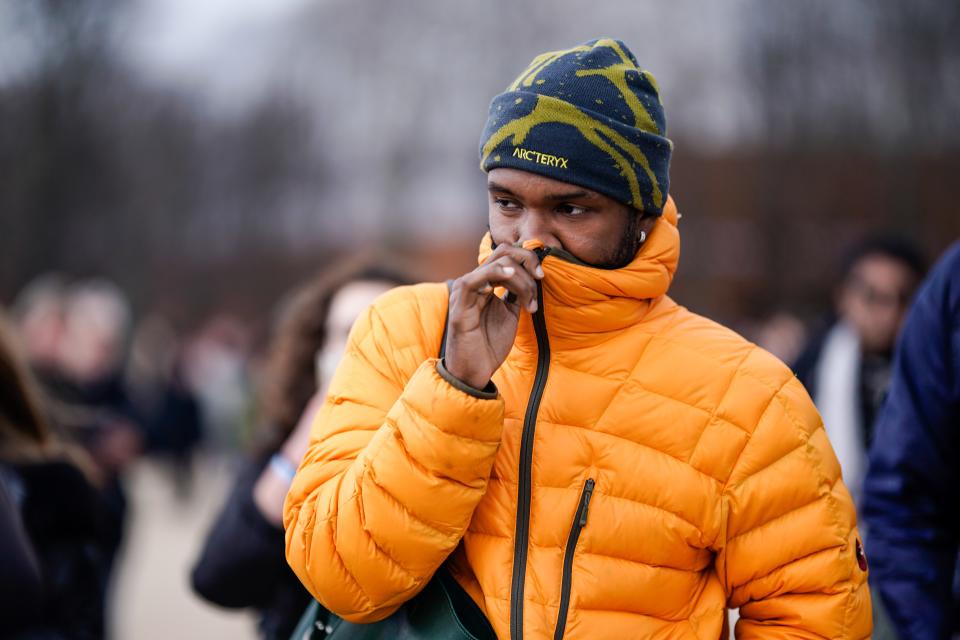How Crunchy Technical Gear Took Over Fashion
In the colder months, you can’t throw a cortado in certain New York neighborhoods without hitting a North Face puffer. Trends come and go, of course—remember extendo tees? But the North Face classic, along with gear from other, equally popular outdoor brands, whether practical (Arc’teryx) or hypebeast-beloved (Stone Island) has been the thing for the fashion-conscious and the average pedestrian - collectively - to wear for a few years now.
The wave isn’t just a few seasons old, either. Supreme has collaborated with the North Face every season since 2007; the digital reselling giant Grailed has launched an ongoing, curated techwear shopping guide with the archival instagram Organiclab.zip, which highlights vintage Nike ACG gear alongside Merrell mocs. Just last month, Virgil Abloh took his end-of-show bow at the Louis Vuitton men’s SS20 presentation in an unexpected electric blue Arc’teryx Rush Jacket. Clearly, boundary-blurring between streetwear and technical gear has been (and continues to be) well underway. But what, exactly, is at the core of this trend’s staying power?

Louis Vuitton : Runway - Paris Fashion Week - Menswear F/W 2020-2021
Nothing exists in a vacuum: technical gear and the fashion world began their slow march to marriage in New York in the early 90s. Though originally designed for mountaineers scaling cliffs in subzero temperatures, the North Face’s Nuptse 700 puffer and GoreTex Mountain Light became fundamental winter wear among hip-hop heads and wealthy prep school kids alike. TNF jackets were hugely popular among rappers—LL Cool J notably donned a cherry red Mountain Light in his ‘93 video for “How I’m Comin’”—and, perhaps more notably, graffiti writers. Not only did the closed-face hoods provide coverage that served as urban camouflage, there was financial gain in the jackets too. Graf writers would “boost”—shoplift—North Face gear from high-end skiing stores around the city, and resell the pieces for marked down prices in New York’s working-class boroughs.
Joey Ones, founder of the “Gore-Tex Hoarders” and probably the country’s leading North Face collector, explains that the brand’s significance was in what it meant, and how it was worn. “New York is known for fashion. The thing is, we started adapting fashion that wasn't meant for us. Polo wasn't meant for street kids, North Face wasn't meant for street kids. When you wore it, it was like a badge of honor because we were poor,” he says. “We don't have the fancy BMWs and we don't have the Rolexes, so the only way to show that we have some type of class or money, even though we don't have money in our pocket, is through our gear.”
Techwear’s recent prominence follows a similar pattern. Historically, hip-hop and skating have been viewed as the wellspring of OG coolness—an appealing combo of grit and authenticity—and have, naturally, been appropriated by individuals not necessarily in those subcultures. This pattern points to the oft-referenced trickle-up theory: that most fashion trends originate on the street, and move up to high fashion, and then back down into the broader mainstream. Twenty-first century trends have particularly followed this logic, initially seen in the rise of Normcore - the mid-2010’s style movement that championed pared-down, brandless, Steve Jobs- and Jerry Seinfeld-indebted style. Mom-and-dad chic eventually gave way to workwear. Utilitarian garments were cosigned by high-fashion designers like Vetements and Calvin Klein, but were also buzzy among streetwear types: the workwear label Carhartt WIP collaborated with Russian skate collective PACCBET in 2018 on a line of reworked Carhartt classics like the Detroit Jacket and Master Pant, amongst a spate of other branded collabs. The sequence of these mini-style movements laid the groundwork for our current techwear moment: they gave precedence to comfort and practicality—and, above all, represented a search for authentic identity through a codified, cosigned uniform.

Street Style - Paris Fashion Week - Menswear F/W 2019-2020 : Day Three
But where Normcore and workwear have increasingly waned in popularity, techwear has, oddly, remained the prevalent mode of dress among, well, just about everyone. There is, of course, the obvious: technical gear is comfortable and withstands the elements (though you probably don’t need a full Gore-Tex jacket for your commute). There’s also the fact that, in a time of unceasing, cataclysmic ecological disasters, techwear garments are inherently sustainable: they are built to last. That Gore-Tex jacket might be more tech than you need, but it will potentially withstand ten-plus years of use—a better deal than a fast-fashion pull.
But there’s a psychological element to the movement, too. It’s part economic: by wearing garments that are associated with the outdoors, we signal our desire for a more bucolic lifestyle rendered increasingly unattainable. (You don’t really need a waterproof shell to get your tweets off.) It’s also a little gloomy, and practical: increasingly bad weather necessitates increasingly technical clothing. And new performance pieces, like these SNOWCROSS ADV LTD Sneakers from Salomon, or this nylon E Vent Hooded Jacket from And Wander, look different than their predecessors. Garments like these—futuristic, athleisure-bent silhouettes vaguely reminiscent of Tron characters or sci-fi soldiers—are saturating the streetwear market. Call it post-apocalyptic cosplay.
“Are we thinking [that] we need to prepare for something where we have to protect ourselves against environmental harm? I think within the next decade, this very well might well be the case,” says Ulrich Lehmann, Associate Professor of Interdisciplinary Design and Arts at The New School. Predicting the future of techwear, he says that “at one point, we might see gear that builds in air filters, because when you live in increasingly [high-polluted areas], you might need it and can’t continue [to buy] these filter masks separate from your gear.”
Techwear, of course, won’t save us; it’s a band-aid for a symptom, and not a fix for the root cause. Lehmann says that techwear brands “have this mirage of performance because, technologically, we live in such a positivist society where technology seems to solve everything, [especially] in talking about the environment. But we've ruined our environment. And then, we just provide technical solutions, instead of changing our behavior.”
So, yeah: the world might be falling apart. But that doesn’t necessarily mean we’re all living in delusions of a utopian existence, far beyond the state our current reality. Maybe, wearing technical gear (and the joy these garments give us) is a way of making the everyday—and the vast, untold future—just a little bit brighter.
Originally Appeared on GQ

